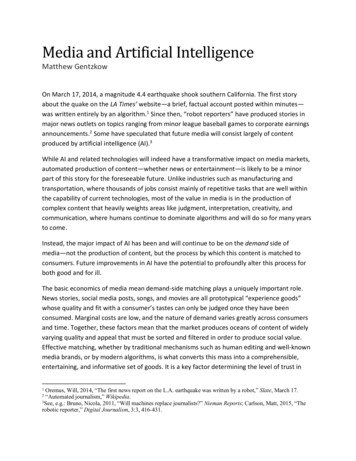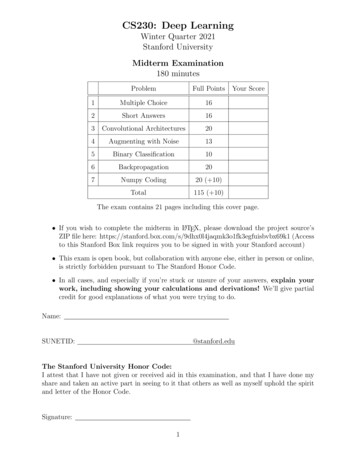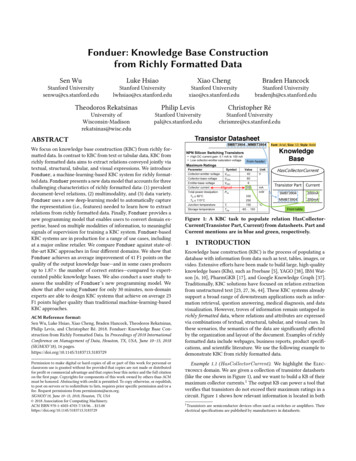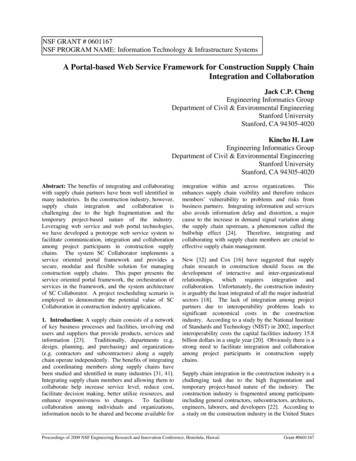
Transcription
Media and Artificial IntelligenceMatthew GentzkowOn March 17, 2014, a magnitude 4.4 earthquake shook southern California. The first storyabout the quake on the LA Times’ website—a brief, factual account posted within minutes—was written entirely by an algorithm.1 Since then, “robot reporters” have produced stories inmajor news outlets on topics ranging from minor league baseball games to corporate earningsannouncements.2 Some have speculated that future media will consist largely of contentproduced by artificial intelligence (AI).3While AI and related technologies will indeed have a transformative impact on media markets,automated production of content—whether news or entertainment—is likely to be a minorpart of this story for the foreseeable future. Unlike industries such as manufacturing andtransportation, where thousands of jobs consist mainly of repetitive tasks that are well withinthe capability of current technologies, most of the value in media is in the production ofcomplex content that heavily weights areas like judgment, interpretation, creativity, andcommunication, where humans continue to dominate algorithms and will do so for many yearsto come.Instead, the major impact of AI has been and will continue to be on the demand side ofmedia—not the production of content, but the process by which this content is matched toconsumers. Future improvements in AI have the potential to profoundly alter this process forboth good and for ill.The basic economics of media mean demand-side matching plays a uniquely important role.News stories, social media posts, songs, and movies are all prototypical “experience goods”whose quality and fit with a consumer’s tastes can only be judged once they have beenconsumed. Marginal costs are low, and the nature of demand varies greatly across consumersand time. Together, these factors mean that the market produces oceans of content of widelyvarying quality and appeal that must be sorted and filtered in order to produce social value.Effective matching, whether by traditional mechanisms such as human editing and well-knownmedia brands, or by modern algorithms, is what converts this mass into a comprehensible,entertaining, and informative set of goods. It is a key factor determining the level of trust inOremus, Will, 2014, “The first news report on the L.A. earthquake was written by a robot,” Slate, March 17.“Automated journalism,” Wikipedia.3See, e.g.: Bruno, Nicola, 2011, “Will machines replace journalists?” Nieman Reports; Carlson, Matt, 2015, “Therobotic reporter,” Digital Journalism, 3:3, 416-431.12
media and the extent to which media can be manipulated by governments, advertisers, orother third parties seeking to persuade. It is what has been thoroughly upended by the adventof social media, which puts a decentralized, algorithm-driven process of matching in place ofthe centralized broadcasting model that has dominated media for centuries. And it is where weneed to focus our attention if we are to address the current crisis of media and democracy.There are three main dimensions along which this matching process can fail. First, quite simply,consumers may not be able to find what they want. Despite tremendous progress in search andrelated technologies, sifting through the mass of content to find the pieces that maximize aconsumer’s utility remains a formidable problem. Second, what consumers want may not bewell aligned with what is best for society. Scholars have long pointed out that individual andsocial objectives are likely to diverge in media, as consumers do not fully account for the waytheir own decisions to be more or less informed about various issues spill over and affect othersvia the political process. Third, actors such as governments and firms may seek to capturemedia in order to shape the selection of content consumers see for their own ends.AI has the potential to dramatically improve the efficiency with which the market matchescontent to consumers. However, the potential gains, and also the possible negativeconsequences, vary greatly across these three dimensions.AI and SearchThe most obvious gains from AI will come in making it easier for consumers to find the mediacontent that they want. This “search” problem encompasses not only search technologiesstrictly defined, but also recommendations, reviews, and an array of other technologies thathelp consumers navigate content.At first glance, search appears to be a prototypical application in which the gains to AI shouldbe large. In general, AI will be effective in domains with (i) a tightly specified decision problem;(ii) measurable, clearly defined objectives; (iii) large volume of data on prior cases. Choosing apiece of content to satisfy a consumer’s immediate demand clearly satisfies (i). Clicks, viewingtime, and other easily captured metrics easily satisfy (ii). And online interactions produce vastamounts of data sufficient for (iii).The gains to AI in search and recommendation problems have indeed been substantial. The“Netflix Challenge”—how to use prior data on individual consumers’ movie ratings to predictfuture ratings—was a canonical application of machine learning. Google search, Amazonproduct recommendations, and the Facebook news feed all rely heavily on AI technologies.Yet in another sense, the gains from AI have been surprisingly small. People have beenpredicting for decades that the defining feature of digital media will be the personalization of
search and matching—going beyond simply sorting web pages or movies to show those mostrelevant to a query, and instead using rich information about a consumer’s prior choices andcharacteristics to select content uniquely suited to their individual tastes. Though people havebeen forecasting a revolution in the quality of personalization for as long as the internet hasexisted, this promise remains largely unrealized.Google search today involves essentially no personalization.4 The only major exception is theuse of location data to define locally relevant results. Two users at the same location enteringthe same query will see the same results in the overwhelming majority of cases. Whilepersonalized recommendations are certainly prominent on sites like Netflix and Amazon, theirquality remains by most accounts surprisingly poor. If I log in to Netflix today, four out of five ofmy “personalized recommendations” are for additional episodes of television series I havealready watched. Amazon’s “Recommendations for You” page offers mostly products I havealready purchased, or products very similar to those I have already purchased—suggesting forexample, that since I recently bought an electric toothbrush, I might like to buy another one.Even on Facebook, where personalization of content and advertising are at the core of thebusiness, evidence suggests that much of what drives variation in users’ newsfeeds is the set ofitems their friends share (combined with non-personalized predictions of the overall popularityof content) rather than finely tailored individual recommendations.5What explains this personalization paradox? One possibility is that the predictions of arevolution in personalization have just been premature, and that AI technology is now reachingthe point where the promise will finally be realized. There is certainly no doubt that progresswill continue, and there will likely be domains where frontier technologies do produce largegains.There may be a more fundamental answer to the paradox, however. Consider three differenttasks that a search algorithm might perform. The first is providing an interface through which aconsumer can communicate what they are looking for at a particular moment—e.g., parsing thetext of a Google search like “Indonesia tsunami news” to determine its meaning. The second isranking content in terms of its average quality or relevance—e.g., determining that a tsunamistory on WSJ or CNN is on average preferred to a similar sounding story on an obscure politicalblog. The third is personalization—e.g., using consumer characteristics or past behavior toHannak, Aniko, Piotr Sapiezynski, Arash Molavi Kakhki, Balachander Krishnamurthy, David Lazer, AlanMislove, and Christo Wilson, 2013, “Measuring Personalization of Web Search,” jin Proceedings of the 22NdInternational Conference on World Wide Web, 527–38, WWW ’13, New York, NY, USA: ACM.4Bakshy, Eytan, Solomon Messing, and Lada A. Adamic, 2015, “Exposure to Ideologically Diverse News andOpinion on Facebook,” Science 348 (6239): 1130–32.5
determine that one consumer might prefer the WSJ story while another might prefer the CNNstory.The relative return to improving each of these tasks depends on the extent to which tastes arecorrelated between consumers and within consumers over time. Personalization will be mostimportant in a world where the key dimension is stable individual differences in preferences—some consumers always like to read highbrow stories about tsunamis while others always liketo read lowbrow stories, say. The other tasks become more important to the extent that what agiven consumer is wants at one moment can be quite different from what she wants atanother, and that for a given need consumers agree to a significant degree about what is mostrelevant.A possible explanation for the personalization paradox, then, is that we have tended to overestimate the importance of stable individual differences relative to the other kinds of variation.Figure 1 shows one example consistent with this hypothesis based on web browsing data from2008. Each point in the plot is an online news or politics site. The x axis shows the averageutility liberals get from the site and the y axis shows the average utility conservatives get fromthe site, where both are inferred from each group’s likelihood of visiting the sites.A world where stable individual differences were key would be one where this plot slopeddownward—some sites give high utility to conservatives and low utility to liberals while othersdo the reverse. In that world, knowing the searcher’s ideology and customizing content to itwould be critical. In fact, the plot is clearly upward sloping with a high positive correlation. It istrue that conservatives like foxnews.com relatively more and that liberals like nytimes.comrelatively more, but this kind of variation is swamped by the fact that everyone likes both ofthese sites more than smaller sites and blogs.There is no question that the quality of search and recommendation systems will continue toimprove dramatically with advances in AI. It may well be, however, that these gains continue tobe more about improved communication with users and overall ranking of content than aboutpersonalization.AI and BiasMany of the deepest problems in media today stem not from an inability to give consumerswhat they want, but from the fact that what they appear to want is not aligned with what isgood for society. Some may demand celebrity news and puppy videos rather than informationthat would make them more informed citizens. Others may prefer misleading partisan contentor outright misinformation rather than more balanced and accurate political news. A
substantial risk in an AI driven future is that algorithms become ever more expert at catering tothese tastes, with disastrous consequences for society.Can AI also be part of the solution? It certainly has a role to play. Facebook and others havedevoted significant effort to training algorithms to identify misinformation. Google can inprinciple tune its algorithms to weight social objectives as well as the likelihood of clicks, forexample by showing accurate information about the Holocaust rather than Holocaust denialsites in response to the query “did the Holocaust happen?”6If we return to the criteria for what makes problems amenable to AI solutions, however, it isclear that we should expect AI to be far less effective in addressing bias than in improvingsearch. Social objectives such as promoting truth and healthy democracy are much harder todefine precisely than giving consumers what they want, and there are few cases in which theyare easily quantifiable. Training data for search is generated automatically by consumer clicks;training data for identifying misinformation, in contrast, must typically be coded by human factcheckers. For other forms of bias, there are essentially no training cases because we lack hardmeasures of the broader social impact of most content.Consistent with this prediction, most efforts to fight bias and misinformation to date haverelied primarily on human judgment. While Facebook’s efforts to fight misinformation certainlyinvolve AI, most of the effective strategies have been things like downranking sites thatconsumers report trusting less, adding “article context” information with additional detailabout sources, and filtering articles based on fact checking. These all involve far more humanjudgment than AI. Similarly, Google’s adjustments to cases like Holocaust denial have relied to asignificant degree on changing instructions to human raters rather than changing the objectivesof AI algorithms.We can hope that future developments in AI will make it more effective in aligning mediacontent with social good. For the near future, however, most progress is likely to continue tocome from human intelligence as curator, editor, and counterweight to the forces pulling moreand more strongly toward satisfying short-run consumer demand.AI and CaptureProbably the oldest, and possibly the most serious, concern is that media may be captured bythird parties that shape or filter content to serve their own objectives. A leading case today isthe massive censorship apparatus of the Chinese government. Other autocratic governmentsengage in similar activity on a smaller scale, and even democratic governments frequentlySullivan, Danny, 2016, “Google’s top results for ‘did the Holocaust happen’ now expunged of denial sites,”searchengineland.com (link).6
intervene to try to suppress content they find objectionable. Governments not only try to affectwhat their own citizens see but what is seen abroad, as in the case of Russian interference in USand European elections. The advertising that fuels most digital markets is itself a form of thirdparty intervention.How is AI likely to change the risk of media capture? Here, again, AI has the potential to bothdramatically worsen the dangers and to be a key part of the solution.On one hand, the Chinese government can use AI to more effectively screen objectionablecontent, monitor citizens to identify dissidents and impending protests, and target propagandamessages to maximize their effectiveness. Russian intelligence operatives can use AI tooptimize their foreign influence campaigns, testing large volumes of content to determine whatworks best. Commercial advertisers can similarly use these tools to optimize and targetcontent.On the other hand, AI may also provide a robust defense against such manipulation. Consumersin autocratic countries can use AI to detect propaganda images and other content that hasbeen manipulated from its original source. Better search technologies from internationalsources can help consumers evade domestic controls. Facebook and other social mediacompanies can use AI to identify foreign interference in elections.Again, the key question is to what extent the relevant objectives can be defined and measuredat large scale. Identifying social media posts that mention sensitive topics such as Tibet or thatcomment critically on the government should be right in the sweet spot in this respect, giventhe ability of modern natural language processing tools to disambiguate meaning. Onlinesurveillance to identify dissidents or impending protests is also well suited to AI, though inthese cases the number of past examples that can be used for training is much smaller in scale.Optimizing for actual persuasive impact is a much harder task. While it is easy to observe thereach of propaganda or advertising, determining its effectiveness is much harder, particularlywhen the goal is to affect a long-run outcome like support for a regime rather than a short-runoutcome like internet purchases.Some of the most relevant research on this problem to date comes from work by Bei Qin, DavidStromberg, and Yanhui Wu on the content of Chinese social media.7 They show, on one hand,that Chinese social media is actually full of government criticism and discussion of sensitivetopics, suggesting either that the regime prefers not to suppress these topics or that theirtechnology does not yet allow them to do so comprehensively. (Which explanation is correcthas important implications for the way we should expect censorship to evolve with better AI.)Qin, Bei, David Strömberg, and Yanhui Wu, 2017, “Why does China allow freer social media? Protests versussurveillance and propaganda,” Journal of Economic Perspectives, 31(1).7
At the same time, these authors show that machine learning applied to social media provides apotentially powerful surveillance tool, with even simple algorithms able to predict theoccurrence of future protests or unrest with high fidelity.ConclusionThere is no question that AI will have profound impacts on media markets. While automation ofproduction may play some role, the unique properties of media goods mean the moreimportant effects are likely to occur on the demand side. Here, there is great potential for socialgood, as AI can make it easier for consumers to navigate the bewildering mass of online contentthrough search and personalized recommendations, and to identify cases where third partiesare attempting to manipulate them. There is also cause for concern, as AI may tilt content moreheavily toward consumer demand in domains where this is at odds with social good, and AItools may be used to more effectively persuade and deceive.
Figure 1: Average utility of news sites for conservatives and liberalsSource: Matthew Gentzkow and Jesse M. Shapiro, 2011, “Ideological segregation online andoffline,” Quarterly Journal of Economics, 126(4), Model Appendix.
Media and Artificial Intelligence Matthew Gentzkow On March 17, 2014, a magnitude 4.4 earthquake shook southern California. The first story about the quake on the LA Times’ website—a brief, factual account posted within minutes— was written entirely by an algorithm.1 Since then, “robot reporters” have p











